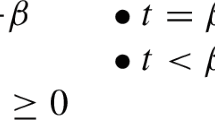Abstract
This paper presents an approach to the belief system based on a computational framework in three levels: first, the logic level with the definition of binary local rules, second, the arithmetic level with the definition of recursive functions and finally the behavioural level with the definition of a recursive construction pattern. Social communication is achieved when different beliefs are expressed, modified, propagated and shared through social nets. This approach is useful to mimic the belief system because the defined functions provide different ways to process the same incoming information as well as a means to propagate it. Our model also provides a means to cross different beliefs so, any incoming information can be processed many times by the same or different functions as it occurs is social nets.




Similar content being viewed by others
References
Alford, J. R., Funk, C. L., & Hibbing, J. R. (2005). Are political orientations genetically transmitted? American Political Science Review, 99, 153–167.
Amodio, D. M., Jost, J., Master, S. L., & Yee, C. M. (2007). Neurocognitive correlates of liberalism and conservatism. Nature Neuroscience, 10, 1246–1247. doi:10.1038/nn1979.
Amodio, D. M., Jost, J., Master, S. L., & Yee, C. M. (2013). Ideologies as complex systems. Journal of Social and Political Psychology, 1(1), 337–363. doi:10.5964/jspp.v1i1.36.
Bello, P. (2012). Cognitive foundations for a computational theory of mindreading. Advances in Cognitive Systems, 1, 59–72.
Dixon, E. (1994). Belief Revision: A Computational Approach.
Duncan, S., & Barrett, L. F. (2007). Affect is a form of cognition: A neurobiological analysis. Cognition and Emotion, 21, 1184–1211. doi:10.1080/02699930701437931.
Eliasmith, C. (2013). How to build a brain: A neural architecture for biological cognition. New York, NY: Oxford University Press.
Findlay, S. D., & Thagard, P. (2011). Emotional change in international negotiation: Analyzing the Camp David accords using cognitive-affective maps. Group Decision and Negotiation. Advance online publication. doi:10.1007/s10726-011-9242-x
Fontaine, J. R. J., Scherer, K. R., Roesch, E. B., & Ellsworth, P. C. (2007). The world of emotions is not two-dimensional. Psychological Science, 18, 1050–1057. doi:10.1111/j.1467-9280.2007.02024.x.
Freeden, M. (2010). Social and psychological bases of ideology and system justification. Edited by John T. Jost, Aaron C.
Gell-Mann, M. (1997). The simple and the complex. In D. Alberts & T. Czerwinski (Eds.), Complexity, global politics, and national security (pp. 3–28). Washington, DC: National Defense University.
Gilbert, N., & Troitzsch, K. (2005). Simulation for the social scientist. Berkshire, UK: Open University Press.
Hagan, J., & Rymond-Richmond, W. (2008). The collective dynamics of racial dehumanization and genocidal victimization in Darfur. American Sociological Review, 73, 875–902. doi:10.1177/000312240807300601.
Haidt, J., Graham, J., & Joseph, C. (2009). Above and below left-right: Ideological narratives and moral foundations. Psychological Inquiry, 20, 110–119. doi:10.1080/10478400903028573.
Hardin, C. D., & Higgins, E. T. (1996). Shared reality: How social verification makes the subjective objective. In E. T. Higgins & R. M. Sorrentino (Eds.), Handbook of motivation and cognition: The interpersonal context (Vol. 3, pp. 28–84). New York, NY: Guilford.
Helbing, D., & Kirman, A. (2013). Rethinking economics using complexity theory. Retrieved from http://www.soms.ethz.ch/paper_economics_complexity_theory
Helbing, D., & Carbone, A., (Eds.). (2012). Participatory science and computing for our complex world. The European Physical Journal: Special Topics, 214(1). doi:10.1140/epjst/e2012-01686-y.
Helbing, D., & Balietti, S. (2012). Agent-based modeling. In D. Helbing (Ed.), Social self-organization (pp. 25–70). New York, NY: Springer.
Homer-Dixon, T., Maynard, J. L., Mildenberger, M., et al. (2013). A complex systems approach to the study of ideology: Cognitive–affective structures and the dynamics of belief systems. Journal of Social and Political Psychology, 1(1), 337–363. doi:10.5964/jspp.v1i1.36.
Howarth, D., Norval, A., & Stavrakakis, Y. (2000). Discourse theory and political analysis: Identities, hegemonies and social change. Manchester, UK: Manchester University Press.
Jost, J. T., Glaser, J., Kruglanski, A. W., & Sulloway, F. J. (2003). Political conservatism as motivated social cognition. Psychological Bulletin, 129, 339–375. doi:10.1037/0033-2909.129.3.339.
Lang, J., & De Sterck, H. (2012). The Arab spring: A simple compartmental model for the dynamics of a revolution. arXiv:1210.1841v1
Leader Maynard, J. (2013). A map of the field of ideological analysis. Journal of Political Ideologies, 18, 299–327. doi:10.1080/13569317.2013.831589.
Liebes, T., Katz, E., & Ribak, R. (1991). Ideological reproduction. Political Behavior, 13, 237–252. doi:10.1007/BF00992921.
Luam, S. (2005). A computational framework for belief change. Berlin: Springer.
Nescolarde-Selva, J. A systemic vision of belief systems and ideologies. Ph.D. Department of Applied Mathematics, University of Alicante, Alicante, Spain.
Schelling, T. C. (1971). Dynamic models of segregation. The Journal of Mathematical Sociology, 1, 143–186.
Sobkowicz, P. (2009). Modelling opinion formation with physics tools: Call for closer link with reality. Journal of Artificial Societies and Social Simulation, 12(1), Article 11. Retrieved from http://jasss.soc.surrey.ac.uk/12/1/11.html
Squazzoni, F. (2012). Agent-based computational sociology. Chichester, UK: Wiley.
Wolf, I., Neumann, J., Schröder, T., & de Haan, G. (2012). The adoption of electric vehicles: An empirical agent-based model of attitude formation and change. In A. Koch (Ed.), Proceedings of the 8th conference of the European Association for Social Simulation (pp. 93–98). Salzburg, Austria: Universität Salzburg.
Author information
Authors and Affiliations
Corresponding author
Rights and permissions
About this article
Cite this article
Pont, M.T.S., Mora, H.M., De Miguel Casado, G. et al. A Computational Model of the Belief System Under the Scope of Social Communication. Found Sci 21, 215–223 (2016). https://doi.org/10.1007/s10699-015-9415-1
Published:
Issue Date:
DOI: https://doi.org/10.1007/s10699-015-9415-1




